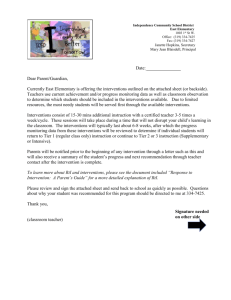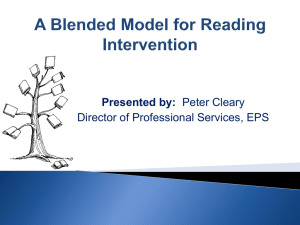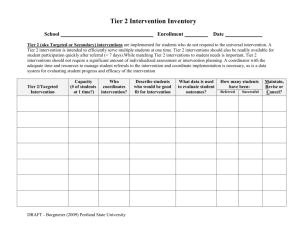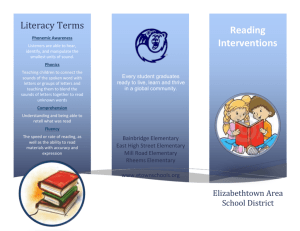Support for all Learners is a living document that exemplifies the
advertisement
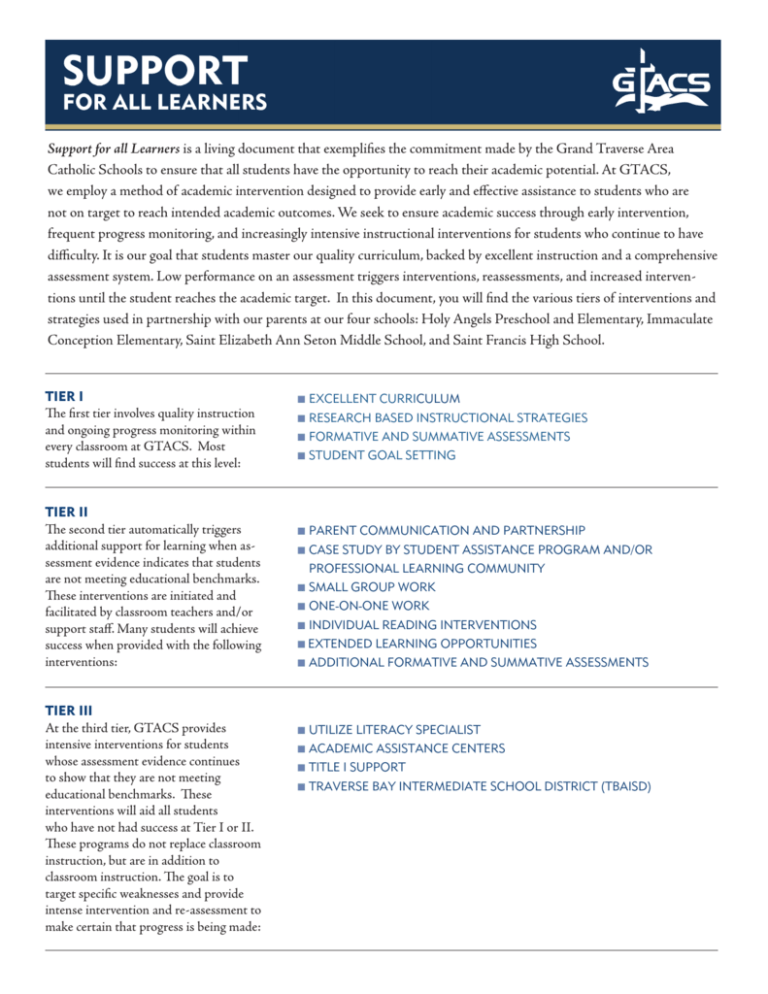
Support for all Learners is a living document that exemplifies the commitment made by the Grand Traverse Area Catholic Schools to ensure that all students have the opportunity to reach their academic potential. At GTACS, we employ a method of academic intervention designed to provide early and effective assistance to students who are not on target to reach intended academic outcomes. We seek to ensure academic success through early intervention, frequent progress monitoring, and increasingly intensive instructional interventions for students who continue to have difficulty. It is our goal that students master our quality curriculum, backed by excellent instruction and a comprehensive assessment system. Low performance on an assessment triggers interventions, reassessments, and increased interventions until the student reaches the academic target. In this document, you will find the various tiers of interventions and strategies used in partnership with our parents at our four schools: Holy Angels Preschool and Elementary, Immaculate Conception Elementary, Saint Elizabeth Ann Seton Middle School, and Saint Francis High School. TIER I The first tier involves quality instruction and ongoing progress monitoring within every classroom at GTACS. Most students will find success at this level: TIER II The second tier automatically triggers additional support for learning when assessment evidence indicates that students are not meeting educational benchmarks. These interventions are initiated and facilitated by classroom teachers and/or support staff. Many students will achieve success when provided with the following interventions: TIER III At the third tier, GTACS provides intensive interventions for students whose assessment evidence continues to show that they are not meeting educational benchmarks. These interventions will aid all students who have not had success at Tier I or II. These programs do not replace classroom instruction, but are in addition to classroom instruction. The goal is to target specific weaknesses and provide intense intervention and re-assessment to make certain that progress is being made: EXCELLENT CURRICULUM n RESEARCH BASED INSTRUCTIONAL STRATEGIES n FORMATIVE AND SUMMATIVE ASSESSMENTS n STUDENT GOAL SETTING n n PARENT COMMUNICATION AND PARTNERSHIP n CASE STUDY BY STUDENT ASSISTANCE PROGRAM AND/OR PROFESSIONAL LEARNING COMMUNITY n SMALL GROUP WORK n ONE-ON-ONE WORK n INDIVIDUAL READING INTERVENTIONS n EXTENDED LEARNING OPPORTUNITIES n ADDITIONAL FORMATIVE AND SUMMATIVE ASSESSMENTS n UTILIZE LITERACY SPECIALIST n ACADEMIC ASSISTANCE CENTERS n TITLE I SUPPORT n TRAVERSE BAY INTERMEDIATE SCHOOL DISTRICT (TBAISD) TIER I The first tier involves quality instruction and ongoing progress monitoring within every classroom at GTACS. Most students will find success at this level when provided with these experiences: GUARANTEED AND VIABLE CURRICULUM uaranteed means that all students have the opportunity G to learn a defined curriculum; viable means that it can be accomplished in the instructional time available. Identified Power Standards • What are all students expected to learn? Prioritized Learning Targets • What is essential? • What is important? • What is good to be familiar with? Connection to World Beyond Classroom COMPREHENSIVE ASSESSMENT SYSTEM Universal Monitoring • • • • • Measures of Academic Progress (MAP) provided by Northwest Evaluation Association (NWEA): 2nd-7th (reading/math) and 5th-7th (science) AIMSweb: K–6th (reading fluency & comprehension) STAR reading by Renaissance Learning: 6th – 8th Saint Francis quarterly departmental assessments Pearson baseline assessment (1–4th) Diagnostic Monitoring • Any tool to identify specific skill or learning deficiencies • Classroom formative assessments • Spelling inventories • Math placements (3–8) Progress Monitoring • Classroom Formative Assessments • Student Assessment Review • STAR: 6th, 7th, 8th (three times a year) • AIMSweb: K–8th • Assessment of Catechesis/Religious Education (ACRE): 5th, 8th, 11th • Accelerated Reader: K–8th • Explore Assessment: 7th and 8th • PLAN Assessment: 9th and 10th • ACT: 11th and12th • PSAT, 11th • Pearson Unit Tests (K–4th) RESEARCHED-BASED INSTRUCTIONAL ASSESSMENT STRATEGIES Adapted from Classroom Instruction that Works* • • • • • • • • • • Questions and Advanced Organizers Non-Linguistic Representations Identifying Similarities and Differences Summarizing and Note Taking Cooperative Learning Generating and Testing Hypotheses Homework and Practice Reinforcing Effort and Providing Recognition Setting Objectives and Providing Feedback Differentiated Instruction STUDENT GOAL SETTING Setting goals based on assessment data: • • • • NWEA – Student Goal Setting Sheets Goal Setting based on AIMSweb Goal Setting based on Explore, PLAN and ACT Test Student Assessment Review EARLY LITERACY INITIATIVE An initiative that was started during the 2010-11 school year has made significant change in our K-4 literacy instruction. We increased our reading from 90 minutes a day to 120 minutes a day in grades K–4. In addition to our six classroom teachers in grades 1 and 2, we utilize additional educators to work in small groups for 30 minutes focusing on phonemic awareness, decoding, comprehension, and fluency. These 30-minute lessons all start concurrently and the standards and benchmarks are the same; the difference is the level of instruction and the teacher per pupil ratio. The struggling students are in the smallest groups while the most advanced students are in larger groups. This new approach has had an impact on the reading abilities of all our students. * Marzano, Robert J., Pickering, Debra J., Pollock, Jane E., Classroom Instruction that Works: Research-based Strategies for Increasing Student Achievement, Pearson: New Jersey, 2005. TIER II The second tier automatically triggers additional support for learning when assessment evidence indicates that students are not meeting educational benchmarks. These interventions are initiated and facilitated by classroom teachers and/or support staff. Many students will achieve success when provided with the following interventions: PARENT COMMUNICATION If a student is at a C- or below or is achieving below grade level after three weeks into a marking period, parents are contacted. STUDENT ASSISTANCE PROGRAM (SAP) and/or PROFESSIONAL LEARNING COMMUNITIES (PLC) Students who fall below class expectations will often be discussed at PLC and/or SAP meetings to identify interventions that may be needed. SMALL GROUP WORK Small group reteaching will often be used when struggling students fall behind the class group. ONE-ON-ONE WORK One-on-one work will often take place when small group work does not provide success. EXTENDED LEARNING OPPORTUNITIES • Before/After School and Lunch (3rd-12th) • Math Support: (3rd-8th) • Eighth Hour (9th-12th) • Eleventh Hour(6th-8th) • Co-teaching support • Math Enrichment (2nd) • Math Counts (6th-8th) • Reading Enrichment (3rd-5th) TIER III At the third tier, GTACS provides intensive interventions for students whose assessment evidence continues to show that they are not meeting educational benchmarks. These interventions will aid all students that have not had success at Tier I or II. These programs do not replace classroom instruction, but are in addition to classroom instruction.The goal is to target specific weaknesses and provide intense intervention and re-assessment to make certain that progress is being made. UTILIZE INTERVENTION SPECIALISTS Intervention Specialists will use the following strategies: Holy Angels Elementary • Intensive and systematic phonics instruction • Learning through literacy games • Working with comprehension and fluency • Teaching strategies on how to learn • Working with vocabulary • Hearing the sounds through auditory manipulatives • Reading Mastery • Reading Strategies • Early Reading Tutor Immaculate Conception Elementary • Working with comprehension and fluency • “Read Naturally” which focuses on fluency, comprehension and writing skills • Leveled reading activities for fluency/comprehension • Small group math help • SRA corrective reading - direct reading instruction program, comprehensive phonics, and fluency and comprehension builder Saint Elizabeth Ann Seton Middle School • SRA corrective reading - direct reading instruction program, comprehensive phonics, fluency builder, progress monitoring • Support throughout the day for those students who need accommodations with instruction and assessment • Math Support (in class individual and/or small group instruction) Saint Francis High School • SRA corrective reading - direct reading instruction program, comprehensive phonics, and fluency and comprehension builder • Individual goal setting and tutoring through the Academic Resource Center (ARC) • Individual instruction through ARC • Intensive Algebra 1 support • Guided study hall INTERVENTION PROGRAMS Reading Club – Holy Angels St. Bridget – Immaculate Conception Seton Center – Saint Elizabeth Ann Seton Academic Assistance Teacher – Saint Francis TRAVERSE BAY AREA INTERMEDIATE SCHOOL DISTRICT (TBAISD) Referral to TBAISD for testing and additional recommendations

